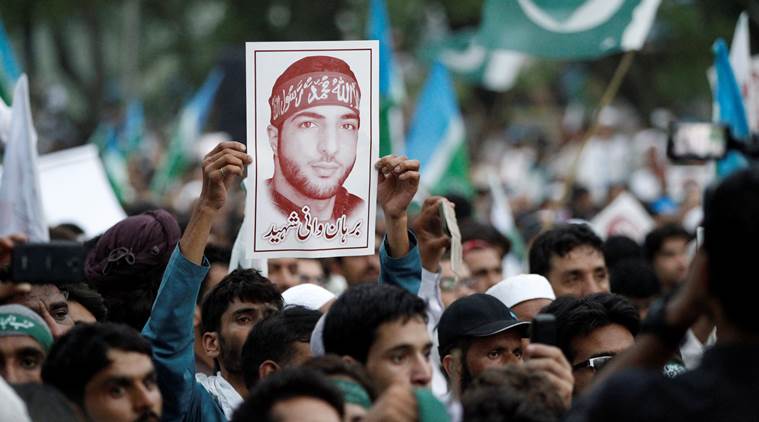By Hamid Khan Wazir
People of Kashmir dwelling either side of the line of control and rest of the world are all-set to observe the fourth martyrdom anniversary of famous young resistance leader of Kashmiri freedom struggle Burhan Muzaffar Wani, who introduced new trends and phenomenally fueled the freedom struggle in the occupied Kashmir to break the shackles of Indian slavery.

In Indian occupied Jammu and Kashmir, posters have appeared in Srinagar and adjoining areas to commemorate the martyrdom anniversary of the beloved Kashmiri commander, who was extra-judicially killed by Indian troops in Bamdoora Kukernaag area of the occupied valley on July 8, in 2016. India had announced Rs. 1 million head-money for Shaheed Wani as he was declared the most-wanted.
The 22-year-old Wani, was a brave son of Kashmir, clinched the distinction to re-infuse a new spirit and more vigour among the Kashmiri youth to perpetuate the over seven-decade-old Kashmir freedom movement through persuading the Kashmiri youth for freedom struggle through the social media besides apprising the external world of the exceptional importance of the Kashmiris indigenous struggle for freedom of the motherland from Indian yoke.
Four years after the martyrdom of popular commander, the occupied Kashmir Valley has changed altogether, which is turned into a burning volcano, as subsequently an exceptionally large number of youth joined the freedom movement since he had a great following in the occupied valley. Afterwards, the Indian fascist forces exacerbated the state terrorism and atrocities to quell the voices of the freedom fighters but all such brutal tactics proved counterproductive due to which Indian fascist government had to resort to stripping the special status of the territory and started issuing Kashmiri domiciles to non-Kashmiri to change the demography of occupied Kashmir.
However, the impact of Wani’s killing is perhaps the most significant change in Valley since the late 1980s, and such unconstitutional and unlawful steps could not deprive of their birthright of right to self-determination, which could be evident from the intensity of the freedom movement.
Kashmir continues to be volatile even after hundreds of killings in the last few years and oppressive measures against dissenting civilians. It was once said that Wani will be more influential from his grave than alive. The current situation vindicates that statement; his popularity has risen exponentially since his death.
Wani, as a student, was way ahead of his peers, a budding cricketer and joyous by temperament. At the age of 15, during the first Intifada in Kashmir in 2010 when ordinary folk exchanged stones with bullets, he was picked up by the forces and subjected to indignity and humiliation. His brother Khalid, a university student, was also roughed up and was beaten to death thereafter. A highly sensitive boy, Wani was pushed towards a course which turned out to be his final destiny.
Wani, in his early 20s, had become a prominent face of separatist sentiment in the Kashmir valley, as he had already given a modern shift to the freedom movement. He built up a following on social media, posting pictures of himself and his associates in combat fatigues. Though the numbers of separatists in the region has declined sharply since the 1990s, he became the face of a small, but youth-led new freedom struggle based in South Kashmir, his appeal apparently heightened by his educated, middle-class roots.
More and more youth were joining him. With his death, the movement gained new life, as South Kashmir became a hotbed for new-age freedom fighting.
A day after his death, former Chief Minister of state Omar Abdullah said that his killing had made him an icon of the disaffected section of the Kashmiri society. He warned that dead Burhan would be deadlier after his death. More and more Kashmiris will join his thoughts.
Not only did he redefine the concept of defiance against the Indian subjugation, he also displayed extraordinary inventive character to engage the new generation of Kashmiris through his public diplomacy. In addition, he restored the humanity of the Kashmiri freedom fighters – who had lost their identity as saviours and had become part of the oppressive architecture that they sought to challenge.
Wani has redefined the concept of the resistance movement to an extent where using the region for political gain will only strengthen people’s resolve against India.
His father, Muzaffar Ahmed Wani appears, quoted as saying, “You also must have had your share. But everyone didn’t become a militant. It depends on how much one can take. Yeh aap ki ghairat pe depend karta hai (It depends on your self-respect). Someone’s ‘Ghairat’ got challenged time and again, so he decided to answer back. Others decided to stay quiet. My son couldn’t bear to see the atrocities and the humiliation, so he was forced to choose the path which he is on right now.”
The question that is being asked now, is if Wani is more dangerous to India now that he is dead. The challenge the government now faces is fighting the ideology that Wani promoted, clearly reflected in the outpouring of sentiment in the wake of his martyrdom.
Nevertheless, doing so will drive the valley to the point of no return. Modi wants to attack the Kashmiris on every front. However, he fails to understand that Kashmiris’ desire for exercising the right to self-determination cannot be suppressed with his evil tactics.
The fact that despite all government machinery is trying its best to erase Wani’s memory from people’s consciousness, people are not forgetting.
